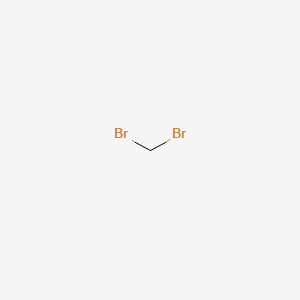

1. Methylene Bromide
2. Methylene Bromide Ion (1+)
3. Methylene Bromide, 79br2-labeled
4. Methylene Bromide, 80br-labeled
5. Methylene Bromide, 80br2-labeled
6. Methylene Bromide, 82br-labeled
7. Methylene Bromide, 82br2-labeled
8. Methylene Dibromide
1. 74-95-3
2. Methylene Bromide
3. Methane, Dibromo-
4. Methylene Dibromide
5. Ch2br2
6. Dibrommethan
7. Dibromomethylene
8. Rcra Waste Number U068
9. Methylenbromid
10. Dibromo-methane
11. 1,1-dibromomethane
12. Chebi:47077
13. Nsc-7293
14. Mfcd00000168
15. V69b659w01
16. Ccris 939
17. Hsdb 1334
18. Nsc 7293
19. Einecs 200-824-2
20. Un2664
21. Rcra Waste No. U068
22. Brn 0969143
23. Dibromo Methane
24. Ai3-52311
25. Unii-v69b659w01
26. Dibromomethane, 99%
27. Dibromomethane, >=99%
28. Dsstox_cid_1557
29. Ec 200-824-2
30. Wln: E1e
31. Dsstox_rid_76209
32. Dsstox_gsid_21557
33. Schembl20033
34. 4-01-00-00078 (beilstein Handbook Reference)
35. Methylene Bromide [mi]
36. Chembl1229889
37. Dtxsid4021557
38. Nsc7293
39. Dibromomethane, Analytical Standard
40. Amy11088
41. Tox21_200410
42. Stl282729
43. Akos009031545
44. Dibromomethane [un2664] [poison]
45. Un 2664
46. Cas-74-95-3
47. Ncgc00248598-01
48. Ncgc00257964-01
49. 2bm
50. 4371-77-1
51. Db-029642
52. Dibromomethane, Puriss., >=98.5% (gc)
53. D0192
54. Ft-0624675
55. S0636
56. Q421736
57. J-520238
58. F1908-0088
59. Dibromomethane Solution, 2000 Mug/ml In Methanol, Analytical Standard
60. Dibromomethane Solution, 5000 Mug/ml In Methanol, Analytical Standard
| Molecular Weight | 173.83 g/mol |
|---|---|
| Molecular Formula | CH2Br2 |
| XLogP3 | 1.8 |
| Hydrogen Bond Donor Count | 0 |
| Hydrogen Bond Acceptor Count | 0 |
| Rotatable Bond Count | 0 |
| Exact Mass | 173.85028 g/mol |
| Monoisotopic Mass | 171.85233 g/mol |
| Topological Polar Surface Area | 0 Ų |
| Heavy Atom Count | 3 |
| Formal Charge | 0 |
| Complexity | 2.8 |
| Isotope Atom Count | 0 |
| Defined Atom Stereocenter Count | 0 |
| Undefined Atom Stereocenter Count | 0 |
| Defined Bond Stereocenter Count | 0 |
| Undefined Bond Stereocenter Count | 0 |
| Covalently Bonded Unit Count | 1 |
Mutagens
Chemical agents that increase the rate of genetic mutation by interfering with the function of nucleic acids. A clastogen is a specific mutagen that causes breaks in chromosomes. (See all compounds classified as Mutagens.)
IT ... DOES NOT APPEAR TO BE ABSORBED SIGNIFICANTLY EVEN WHEN APPLIED REPEATEDLY /TO EYES AND SKIN OF RABBITS/.
Clayton, G.D., F.E. Clayton (eds.) Patty's Industrial Hygiene and Toxicology. Volumes 2A, 2B, 2C, 2D, 2E, 2F: Toxicology. 4th ed. New York, NY: John Wiley & Sons Inc., 1993-1994., p. 4052
IT IS METABOLIZED TO CARBON MONOXIDE AND BROMIDE.
Clayton, G.D., F.E. Clayton (eds.) Patty's Industrial Hygiene and Toxicology. Volumes 2A, 2B, 2C, 2D, 2E, 2F: Toxicology. 4th ed. New York, NY: John Wiley & Sons Inc., 1993-1994., p. 4052
MASS SPECTRAL STUDIES USING (18)O2 SHOWED THAT (18)O-CO WAS PRODUCED INDICATING THAT OXYGEN WAS INCORPORATED DURING THE REACTION. A PRIMARY DEUTERIUM ISOTOPE EFFECT WAS OBSERVED FOR CONVERSION OF DICHLOROMETHANE TO CARBON MONOXIDE BOTH BY LONG-EVANS RAT HEPATIC MICROSOMAL FRACTIONS & BY STANNOUS PHOSPHATE MODEL SYSTEM. INCUBATION OF DIBROMOMETHANE IN THE MODEL SYSTEM IN THE PRESENCE OF 3,4-DIMETHYLANILINE RESULTED IN FORMATION OF 3,4-FORMOXYLIDIDE, SUPPORTING THE INTERMEDIACY OF A FORMYL HALIDE. A MECHANISM FOR THE METABOLISM OF DIHALOMETHANES TO CARBON MONOXIDE IS PROPOSED.
PMID:728186 KUBIC VL, ANDERS MW; BIOCHEM PHARMACOL 27 (19): 2349-55 (1978)
Halogenated methanes, in particular the brominated homologs, including dibromomethane and tribromomethane were subjected to biochemical decomposition in vitro by the cytochrome p450 rich fraction of the monooxygenase liver system. No significant contribution of GSH addition to the overall rate of metabolism of the halogenated methanes could be observed.
Buether H et al; Chemosphere 15 (8): 1043-62 (1986)
Treatment of Sprague-Dawley rats with sodium phenobarbital (50 mg/kg in 0.9% saline for 4 days) or 3-methylcholanthrene (20 mg/kg in corn oil for 2 days) resulted in increased metabolism of dibromomethane (3 m mol/kg) to carbon monoxide.
PMID:7434361 Stevens JL et al; Toxicol Appl Pharmacol 55 (3): 484-89 (1980)
Biotransformation of dihalomethanes leads to dehalogenation & end product is carbon monoxide. In the case of dichloromethane the carbon monoxide appears to arise from formyl halide. This intermediate, as an alternative to losing carbon monoxide, can covalently bind to cellular protein or lipid. The involvement of nonmicrosomal enzymes in dihalomethane biotransformation leads to prodn of formaldehyde & halide. A necessary step is the reaction of dihalomethane with glutathione, which results in loss of one halide. The resulting halomethylglutathione is postulated to undergo nonenzymatic hydrolytic dehalogenation leaving hydroxymethylglutathione. The next step would result in the release of the hydroxymethyl group as formaldehyde. Alternatively it has been shown that in the presence of formaldehyde dehydrogenase & NAD /nicotinamide-adenine dinucleotide/ formic acid can be formed. /Dichloromethane/
Doull, J., C.D.Klassen, and M.D. Amdur (eds.). Casarett and Doull's Toxicology. 3rd ed., New York: Macmillan Co., Inc., 1986., p. 647
... REPEATED 6 HR EXPOSURES /OF DOGS/ TO EITHER 25, 75, OR 150 PPM /METHYLENE BROMIDE/ FOR 90 DAYS. PLASMA CLEARANCE WAS AT LEAST BIPHASIC WITH ILL DEFINED ALPHA PHASE & A TERMINAL PHASE (HALF LIFE 103 + OR - 14 MIN) @ ALL 3 CONCN.
Clayton, G.D., F.E. Clayton (eds.) Patty's Industrial Hygiene and Toxicology. Volumes 2A, 2B, 2C, 2D, 2E, 2F: Toxicology. 4th ed. New York, NY: John Wiley & Sons Inc., 1993-1994., p. 4052